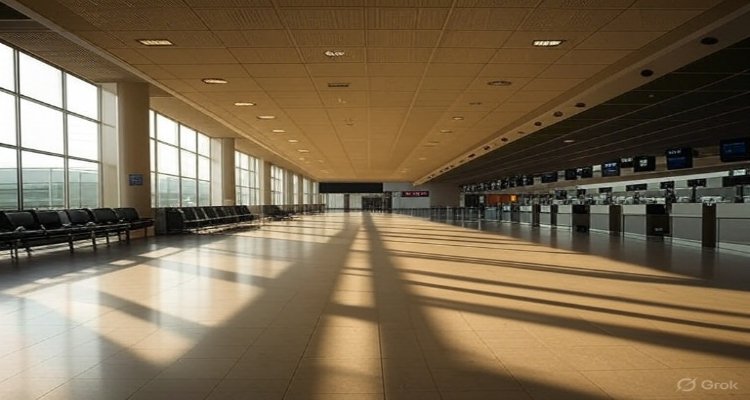Why Some Countries Have “Ghost Airports” with No Flights
Around the world, billions have been spent on airports that sit nearly empty. We explore why “ghost airports” exist and what they reveal about politics, planning, and economic missteps.
Introduction: When Runways Lead Nowhere
At sunrise, the tarmac glistens under a thin layer of dew. A terminal, large enough to handle thousands of passengers daily, stands eerily quiet. Conveyor belts remain still, immigration counters gather dust, and departure boards flash a permanent “No Flights Scheduled.” This is not a scene from an abandoned movie set—it’s a reality in several countries, where “ghost airports” have become modern monuments to failed planning, overambition, or shifting economic tides.
The Rise of ‘Ghost Airports’
The term “ghost airport” refers to aviation hubs built with the expectation of high passenger traffic but that end up operating far below capacity—or worse, with no flights at all. While some are brand new and never truly open for business, others once thrived but now struggle with dwindling demand.
From Spain’s Castellón–Costa Azahar Airport—built in 2011 at a cost of over €150 million yet lacking commercial flights for years—to China’s rural mega-terminals that see fewer than a handful of planes daily, these empty infrastructures are not isolated cases. India, Greece, and parts of Eastern Europe also host their share of underused airports.
Why They’re Built in the First Place
Building an airport is often framed as a symbol of economic progress. Governments pitch them as catalysts for tourism, trade, and local job creation. But several factors can lead to overestimation and eventual underuse:
- Political Ambition Over Market Reality – In some cases, airports are built to fulfill campaign promises or as prestige projects, regardless of actual passenger demand forecasts.
- Economic Shifts – A booming tourist destination during planning may see a downturn before construction ends, leaving a shiny facility with no visitors.
- Misaligned Location – Airports far from major cities or poorly connected by road and rail often fail to attract passengers.
- Competition from Larger Hubs – New regional airports can be overshadowed by established international hubs nearby.
Main Developments: Recent Global Examples
- Castellón Airport, Spain – Opened without a single airline committed to service, it remained unused for nearly four years.
- Mattala Rajapaksa International Airport, Sri Lanka – Dubbed “the world’s emptiest international airport,” it operated at under 5% capacity, largely due to its remote location and lack of airline interest.
- China’s Rapid Expansion – Between 2010 and 2020, China built dozens of regional airports to boost rural economies, but some now process fewer than 1,000 passengers a year.
Expert Insight & Public Reaction
Aviation economist Dr. Laura Nguyen explains,
“The core problem is a disconnect between aviation demand forecasting and political decision-making. Airports need a consistent flow of passengers to survive. If that’s not there, no amount of infrastructure can make it work.”
Meanwhile, public sentiment often turns sour. Residents see these empty airports as symbols of wasted taxpayer money, while some locals—ironically—appreciate the quiet, using terminal roads for cycling or jogging in the absence of traffic.
Impact & Implications
The consequences of ghost airports go beyond idle buildings:
- Financial Losses – Maintenance, security, and staffing costs continue even with no revenue.
- Missed Opportunities – Funds tied up in underused airports could have been invested in healthcare, education, or essential infrastructure.
- Environmental Concerns – Large-scale construction without proportional usage leaves a heavy carbon footprint for little benefit.
However, not all ghost airports remain empty forever. Some are repurposed for cargo operations, pilot training facilities, or emergency hubs during crises, such as COVID-19, when empty runways became staging grounds for humanitarian flights.
Looking Forward: Can They Be Saved?
The future of ghost airports depends on creative adaptation. Analysts suggest:
- Diversifying Use – Incorporating logistics hubs, technology parks, or film production spaces.
- Incentivizing Airlines – Offering reduced fees or subsidies to attract carriers.
- Improving Connectivity – Building better transport links to urban centers.
If lessons are learned, these silent terminals could one day find their purpose—though perhaps not the one their builders originally envisioned.
Conclusion
Ghost airports are a cautionary tale of overambition meeting harsh reality. They remind us that progress cannot be measured solely by the scale of infrastructure, but by its lasting impact on people’s lives. As the aviation industry faces economic pressures, future projects may tread more carefully, ensuring that runways lead somewhere—and not to an empty departure hall.
Disclaimer: This article is for informational purposes only and does not provide investment or travel advice. All examples are based on publicly available information from credible sources.











